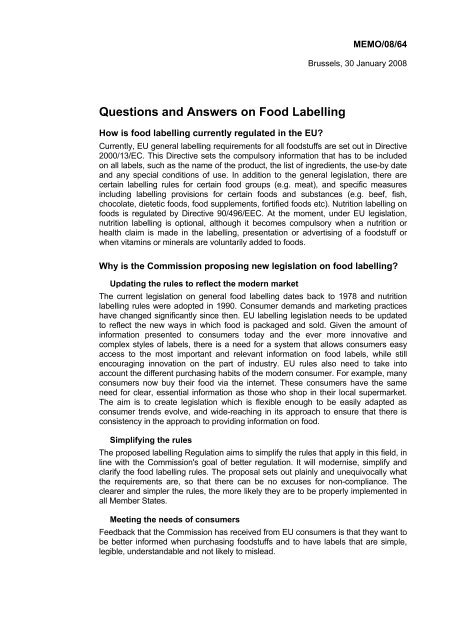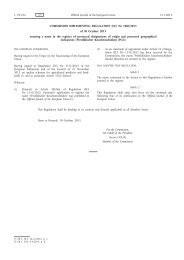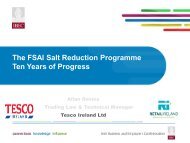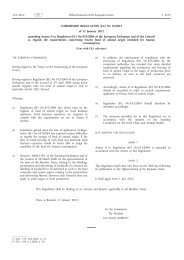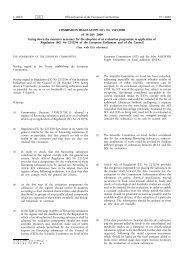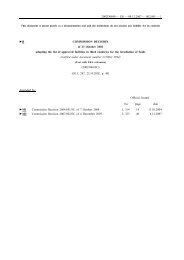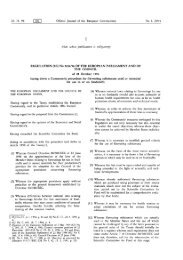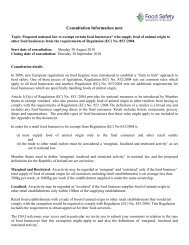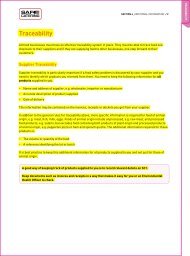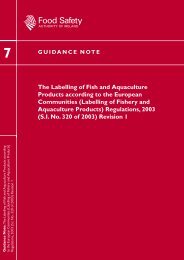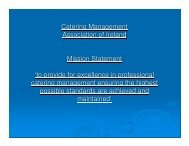Questions and Answers on Food Labelling
Questions and Answers on Food Labelling
Questions and Answers on Food Labelling
Create successful ePaper yourself
Turn your PDF publications into a flip-book with our unique Google optimized e-Paper software.
<str<strong>on</strong>g>Questi<strong>on</strong>s</str<strong>on</strong>g> <str<strong>on</strong>g>and</str<strong>on</strong>g> <str<strong>on</strong>g>Answers</str<strong>on</strong>g> <strong>on</strong> <strong>Food</strong> <strong>Labelling</strong><br />
How is food labelling currently regulated in the EU?<br />
MEMO/08/64<br />
Brussels, 30 January 2008<br />
Currently, EU general labelling requirements for all foodstuffs are set out in Directive<br />
2000/13/EC. This Directive sets the compulsory informati<strong>on</strong> that has to be included<br />
<strong>on</strong> all labels, such as the name of the product, the list of ingredients, the use-by date<br />
<str<strong>on</strong>g>and</str<strong>on</strong>g> any special c<strong>on</strong>diti<strong>on</strong>s of use. In additi<strong>on</strong> to the general legislati<strong>on</strong>, there are<br />
certain labelling rules for certain food groups (e.g. meat), <str<strong>on</strong>g>and</str<strong>on</strong>g> specific measures<br />
including labelling provisi<strong>on</strong>s for certain foods <str<strong>on</strong>g>and</str<strong>on</strong>g> substances (e.g. beef, fish,<br />
chocolate, dietetic foods, food supplements, fortified foods etc). Nutriti<strong>on</strong> labelling <strong>on</strong><br />
foods is regulated by Directive 90/496/EEC. At the moment, under EU legislati<strong>on</strong>,<br />
nutriti<strong>on</strong> labelling is opti<strong>on</strong>al, although it becomes compulsory when a nutriti<strong>on</strong> or<br />
health claim is made in the labelling, presentati<strong>on</strong> or advertising of a foodstuff or<br />
when vitamins or minerals are voluntarily added to foods.<br />
Why is the Commissi<strong>on</strong> proposing new legislati<strong>on</strong> <strong>on</strong> food labelling?<br />
Updating the rules to reflect the modern market<br />
The current legislati<strong>on</strong> <strong>on</strong> general food labelling dates back to 1978 <str<strong>on</strong>g>and</str<strong>on</strong>g> nutriti<strong>on</strong><br />
labelling rules were adopted in 1990. C<strong>on</strong>sumer dem<str<strong>on</strong>g>and</str<strong>on</strong>g>s <str<strong>on</strong>g>and</str<strong>on</strong>g> marketing practices<br />
have changed significantly since then. EU labelling legislati<strong>on</strong> needs to be updated<br />
to reflect the new ways in which food is packaged <str<strong>on</strong>g>and</str<strong>on</strong>g> sold. Given the amount of<br />
informati<strong>on</strong> presented to c<strong>on</strong>sumers today <str<strong>on</strong>g>and</str<strong>on</strong>g> the ever more innovative <str<strong>on</strong>g>and</str<strong>on</strong>g><br />
complex styles of labels, there is a need for a system that allows c<strong>on</strong>sumers easy<br />
access to the most important <str<strong>on</strong>g>and</str<strong>on</strong>g> relevant informati<strong>on</strong> <strong>on</strong> food labels, while still<br />
encouraging innovati<strong>on</strong> <strong>on</strong> the part of industry. EU rules also need to take into<br />
account the different purchasing habits of the modern c<strong>on</strong>sumer. For example, many<br />
c<strong>on</strong>sumers now buy their food via the internet. These c<strong>on</strong>sumers have the same<br />
need for clear, essential informati<strong>on</strong> as those who shop in their local supermarket.<br />
The aim is to create legislati<strong>on</strong> which is flexible enough to be easily adapted as<br />
c<strong>on</strong>sumer trends evolve, <str<strong>on</strong>g>and</str<strong>on</strong>g> wide-reaching in its approach to ensure that there is<br />
c<strong>on</strong>sistency in the approach to providing informati<strong>on</strong> <strong>on</strong> food.<br />
Simplifying the rules<br />
The proposed labelling Regulati<strong>on</strong> aims to simplify the rules that apply in this field, in<br />
line with the Commissi<strong>on</strong>'s goal of better regulati<strong>on</strong>. It will modernise, simplify <str<strong>on</strong>g>and</str<strong>on</strong>g><br />
clarify the food labelling rules. The proposal sets out plainly <str<strong>on</strong>g>and</str<strong>on</strong>g> unequivocally what<br />
the requirements are, so that there can be no excuses for n<strong>on</strong>-compliance. The<br />
clearer <str<strong>on</strong>g>and</str<strong>on</strong>g> simpler the rules, the more likely they are to be properly implemented in<br />
all Member States.<br />
Meeting the needs of c<strong>on</strong>sumers<br />
Feedback that the Commissi<strong>on</strong> has received from EU c<strong>on</strong>sumers is that they want to<br />
be better informed when purchasing foodstuffs <str<strong>on</strong>g>and</str<strong>on</strong>g> to have labels that are simple,<br />
legible, underst<str<strong>on</strong>g>and</str<strong>on</strong>g>able <str<strong>on</strong>g>and</str<strong>on</strong>g> not likely to mislead.
This will help them to make informed decisi<strong>on</strong>s <strong>on</strong> the food that they buy, <str<strong>on</strong>g>and</str<strong>on</strong>g> could<br />
c<strong>on</strong>tribute to better lifestyle choices. However, at the moment, c<strong>on</strong>sumers do not feel<br />
that they are given the informati<strong>on</strong> they need in an easy to access way. Firstly, there<br />
is a wide disparity in the extent of the availability of nutriti<strong>on</strong> labelling between<br />
various Member States. This means that some EU c<strong>on</strong>sumers are given far less<br />
informati<strong>on</strong> than others. In additi<strong>on</strong>, the essential informati<strong>on</strong> is presented in a wide<br />
variety of ways, depending <strong>on</strong> the product, <str<strong>on</strong>g>and</str<strong>on</strong>g> is often over-shadowed by other<br />
informati<strong>on</strong> <strong>on</strong> packaging, such as marketing informati<strong>on</strong>. There is a general<br />
c<strong>on</strong>sensus that the current system of food labelling is not working in a way that really<br />
resp<strong>on</strong>ds to c<strong>on</strong>sumers' needs, <str<strong>on</strong>g>and</str<strong>on</strong>g> therefore needs to be changed.<br />
Meeting the needs of industry<br />
The new Regulati<strong>on</strong> aims to create a clearer, fairer system for all food operators in<br />
Europe, by laying down clear-cut rules which are proporti<strong>on</strong>ate, flexible to the<br />
c<strong>on</strong>stantly changing market <str<strong>on</strong>g>and</str<strong>on</strong>g> which do not pose unnecessary burdens.<br />
Reas<strong>on</strong>able transiti<strong>on</strong> periods should allow industry to adapt smoothly to the new<br />
requirements laid down by the new legislati<strong>on</strong>.<br />
What are the key elements of the proposal?<br />
General provisi<strong>on</strong>s<br />
Overall, the general provisi<strong>on</strong>s for food labelling will remain the same under the new<br />
Regulati<strong>on</strong>. This means that certain compulsory informati<strong>on</strong> has to be included <strong>on</strong> all<br />
labels, such as the name of the product, the list of ingredients, the best before or<br />
use-by date of the product, any special c<strong>on</strong>diti<strong>on</strong>s of use <str<strong>on</strong>g>and</str<strong>on</strong>g> the name <str<strong>on</strong>g>and</str<strong>on</strong>g> address<br />
of the manufacturer. The informati<strong>on</strong> must be clear, easy to read <str<strong>on</strong>g>and</str<strong>on</strong>g> not misleading<br />
to the c<strong>on</strong>sumer. In additi<strong>on</strong>, the Commissi<strong>on</strong> is proposing to make nutriti<strong>on</strong><br />
informati<strong>on</strong> m<str<strong>on</strong>g>and</str<strong>on</strong>g>atory <strong>on</strong> nearly all processed foods (see next point). By setting<br />
down general requirements which apply to all food labels, the aim is to ensure that<br />
c<strong>on</strong>sumers can rely <strong>on</strong> a basic uniformity in the informati<strong>on</strong> that they are presented<br />
with, while food operators can benefit from working in a level playing-field.<br />
Fr<strong>on</strong>t-of-pack nutriti<strong>on</strong> labelling<br />
Under the draft Regulati<strong>on</strong>, fr<strong>on</strong>t-of-pack nutriti<strong>on</strong> informati<strong>on</strong> would become<br />
m<str<strong>on</strong>g>and</str<strong>on</strong>g>atory for nearly all pre-packaged processed foods. There would be <strong>on</strong> the fr<strong>on</strong>t<br />
of the packaging the energy, fat, saturated fat, carbohydrates with specific reference<br />
to sugars <str<strong>on</strong>g>and</str<strong>on</strong>g> salt c<strong>on</strong>tent of the product, expressed in terms of per 100ml/100g or<br />
per porti<strong>on</strong>. In additi<strong>on</strong>, the amount of these elements in relati<strong>on</strong> to the reference<br />
intakes will have to be indicated. Operators can choose to include additi<strong>on</strong>al nutriti<strong>on</strong><br />
informati<strong>on</strong> <strong>on</strong> the fr<strong>on</strong>t of pack, <strong>on</strong> c<strong>on</strong>diti<strong>on</strong> that it does not detrimentally affect the<br />
visibility <str<strong>on</strong>g>and</str<strong>on</strong>g> legibility of the m<str<strong>on</strong>g>and</str<strong>on</strong>g>atory informati<strong>on</strong>. As before <str<strong>on</strong>g>and</str<strong>on</strong>g>, in line with the<br />
Nutriti<strong>on</strong> <str<strong>on</strong>g>and</str<strong>on</strong>g> Health Claims Regulati<strong>on</strong> (see IP/05/668), nutriti<strong>on</strong> informati<strong>on</strong> also<br />
has to be provided to support any nutriti<strong>on</strong> or health claim made in relati<strong>on</strong> to a<br />
product. Alsol, in line with the Regulati<strong>on</strong> <strong>on</strong> the additi<strong>on</strong> of vitamins <str<strong>on</strong>g>and</str<strong>on</strong>g> minerals<br />
<str<strong>on</strong>g>and</str<strong>on</strong>g> certain other substances to foods, nutriti<strong>on</strong> informati<strong>on</strong> has to be provided if<br />
vitamins <str<strong>on</strong>g>and</str<strong>on</strong>g> minerals have been voluntarily added to the food.<br />
Legibility<br />
In order to avoid the comm<strong>on</strong> problem of essential informati<strong>on</strong> being too small or<br />
hidden for the c<strong>on</strong>sumer to easily read <strong>on</strong> food labels, the draft Regulati<strong>on</strong> states<br />
that m<str<strong>on</strong>g>and</str<strong>on</strong>g>atory informati<strong>on</strong> must be printed in a minimum size (3mm), with a<br />
significant c<strong>on</strong>trast between the writing <str<strong>on</strong>g>and</str<strong>on</strong>g> the background. Voluntary informati<strong>on</strong><br />
(e.g. slogans or claims) must not be presented in a way that adversely affects the<br />
presentati<strong>on</strong> of m<str<strong>on</strong>g>and</str<strong>on</strong>g>atory informati<strong>on</strong>.<br />
2
Allergen labelling<br />
Currently, the presence of allergens must be clearly indicated <strong>on</strong> all pre-packed food<br />
sold in the EU. However, 70% of anaphylactic shocks occur when people are eating<br />
out, <str<strong>on</strong>g>and</str<strong>on</strong>g> people with allergies need to have the informati<strong>on</strong> to protect themselves<br />
regardless of whether the food is packaged or not. Therefore, the Commissi<strong>on</strong> is<br />
proposing the extensi<strong>on</strong> of m<str<strong>on</strong>g>and</str<strong>on</strong>g>atory allergen labelling to n<strong>on</strong>-prepacked food,<br />
including food sold in restaurants <str<strong>on</strong>g>and</str<strong>on</strong>g> other catering establishments, asking for<br />
allergens to be displayed or be available at the request of the c<strong>on</strong>sumers. There is<br />
an EU list of identified allergens which must be labelled, including peanuts, milk, fish<br />
<str<strong>on</strong>g>and</str<strong>on</strong>g> mustard.<br />
<strong>Labelling</strong> of ingredients of alcoholic beverages<br />
The proposal improves <str<strong>on</strong>g>and</str<strong>on</strong>g> clarifies the current situati<strong>on</strong> c<strong>on</strong>cerning the listing of<br />
ingredients of alcoholic beverages in an attempt to c<strong>on</strong>ciliate the c<strong>on</strong>sumers' needs<br />
for informati<strong>on</strong> with the specificities in the producti<strong>on</strong> of such products. To take into<br />
account the c<strong>on</strong>sumers' need for informati<strong>on</strong>, the proposal provides that ready to<br />
drink mixed alcoholic beverages, frequently referred to as alcopops, should include<br />
an ingredients list. Given the specificities of wine, spirits <str<strong>on</strong>g>and</str<strong>on</strong>g> beer, <str<strong>on</strong>g>and</str<strong>on</strong>g> with a view to<br />
ensure a c<strong>on</strong>sistent approach <str<strong>on</strong>g>and</str<strong>on</strong>g> coherence in this sector, it is foreseen that the<br />
Commissi<strong>on</strong> reports <strong>on</strong> the state-of-play <strong>on</strong> the Community rules regarding the<br />
ingredients list <str<strong>on</strong>g>and</str<strong>on</strong>g> nutriti<strong>on</strong> labelling of such products with the possibility of<br />
measures to be adopted. .<br />
Origin labelling<br />
As is currently the case, the draft Regulati<strong>on</strong> proposes to keep country of origin or<br />
place of provenance labelling <strong>on</strong> food voluntary, unless its absence could mislead<br />
c<strong>on</strong>sumers. However, certain criteria are laid down for producers who do wish to<br />
put the country of origin or place of provenance <strong>on</strong> the label of their products. In<br />
line with internati<strong>on</strong>al st<str<strong>on</strong>g>and</str<strong>on</strong>g>ards (WTO <str<strong>on</strong>g>and</str<strong>on</strong>g> Codex), the country of origin should be<br />
determined in accordance with the Community Custom Code. The country of origin<br />
or place of provenance of the main ingredients must also be listed if those<br />
ingredients originate from a different place than the finished product. For example,<br />
butter churned in Belgium from Danish milk could be labelled as "produced in<br />
Belgium from Danish milk". Producers may, if they wish to, put a "made in the EU"<br />
label <strong>on</strong> their foodstuffs, provided the food was produced in the EU. Alternatively,<br />
they can choose to indicate the Member State.<br />
Why does the Commissi<strong>on</strong> c<strong>on</strong>sider m<str<strong>on</strong>g>and</str<strong>on</strong>g>atory fr<strong>on</strong>t-of-pack labelling<br />
necessary, <str<strong>on</strong>g>and</str<strong>on</strong>g> how did it choose the elements which must be<br />
displayed?<br />
Following a comprehensive impact assessment carried out <strong>on</strong> this issue, the<br />
Commissi<strong>on</strong> decided to make nutriti<strong>on</strong> labelling m<str<strong>on</strong>g>and</str<strong>on</strong>g>atory <strong>on</strong> the fr<strong>on</strong>t of pack<br />
because this was seen to provide c<strong>on</strong>sumers with the most readily accessible<br />
informati<strong>on</strong> <str<strong>on</strong>g>and</str<strong>on</strong>g> have the greatest potential impact <strong>on</strong> c<strong>on</strong>sumer decisi<strong>on</strong>s. Requiring<br />
fr<strong>on</strong>t-of-pack labelling avoids situati<strong>on</strong>s whereby m<str<strong>on</strong>g>and</str<strong>on</strong>g>atory essential informati<strong>on</strong><br />
can be hidden or difficult to see when the food is displayed for sale.<br />
The Commissi<strong>on</strong> focussed in its proposal <strong>on</strong> those nutriti<strong>on</strong>al elements that are<br />
relevant to public health <str<strong>on</strong>g>and</str<strong>on</strong>g> which can be c<strong>on</strong>sumed in excess of dietary<br />
recommendati<strong>on</strong>s. In additi<strong>on</strong>, c<strong>on</strong>sumer research shows that energy, fat, saturates,<br />
carbohydrates <str<strong>on</strong>g>and</str<strong>on</strong>g> specifically sugars <str<strong>on</strong>g>and</str<strong>on</strong>g> salt are the nutriti<strong>on</strong>al comp<strong>on</strong>ents of<br />
most interest to citizens.<br />
3
Reliable informati<strong>on</strong> <strong>on</strong> the amount of energy <str<strong>on</strong>g>and</str<strong>on</strong>g> certain nutrients in food is of<br />
particular importance when trying to follow a balanced diet. Following extensive<br />
c<strong>on</strong>sultati<strong>on</strong>s, the Commissi<strong>on</strong> decided to limit the m<str<strong>on</strong>g>and</str<strong>on</strong>g>atory fr<strong>on</strong>t-of-pack labelling<br />
to just these elements, so that c<strong>on</strong>sumers are not overwhelmed by too much detailed<br />
informati<strong>on</strong> <str<strong>on</strong>g>and</str<strong>on</strong>g> can focus <strong>on</strong> the key data.<br />
Will producers who already display nutriti<strong>on</strong> informati<strong>on</strong> <strong>on</strong> the fr<strong>on</strong>t<br />
of the pack have to make any changes to their labelling under the<br />
proposed Regulati<strong>on</strong>?<br />
Many foodstuffs across the EU already carry nutriti<strong>on</strong> informati<strong>on</strong> in wheel form or<br />
simply as a horiz<strong>on</strong>tal chart <strong>on</strong> the fr<strong>on</strong>t of the pack. No uniform system for the<br />
display of the fr<strong>on</strong>t-of-pack informati<strong>on</strong> is laid down in the proposal, except for the<br />
order of the nutrients <str<strong>on</strong>g>and</str<strong>on</strong>g> the general requirements for legibility. Therefore, provided<br />
the m<str<strong>on</strong>g>and</str<strong>on</strong>g>atory elements are displayed clearly <strong>on</strong> the fr<strong>on</strong>t of the pack, in line with<br />
the requirements set out in the Commissi<strong>on</strong>'s proposal, producers are free to decide<br />
how they wish to display this informati<strong>on</strong>.<br />
Are any foods <str<strong>on</strong>g>and</str<strong>on</strong>g> drinks exempt from the m<str<strong>on</strong>g>and</str<strong>on</strong>g>atory nutriti<strong>on</strong><br />
labelling requirements?<br />
Yes. Annex IV of the draft Regulati<strong>on</strong> lists the foods which would be exempt from the<br />
required nutriti<strong>on</strong> labelling. These are unprocessed foods or those which are usually<br />
not nutriti<strong>on</strong>ally significant in the diet overall. They include:<br />
- Unprocessed food comprised of a single ingredient (e.g. fresh steak, apples)<br />
- Water<br />
- Smoked or matured food comprised of a single ingredient or category of food<br />
- Teas <str<strong>on</strong>g>and</str<strong>on</strong>g> coffees<br />
- Herbs, spices, salt <str<strong>on</strong>g>and</str<strong>on</strong>g> vinegars<br />
- Flavourings, food colours <str<strong>on</strong>g>and</str<strong>on</strong>g> other food improvement agents or processing<br />
aids<br />
<strong>Food</strong> sold in packaging with a surface area less than 25cm 2 is also exempt from the<br />
nutriti<strong>on</strong> labelling requirements, as is inner packaging that is not designed for sale<br />
without the outer packaging.<br />
Why does the proposal require the proporti<strong>on</strong> of reference intake to be<br />
indicated as part of the nutriti<strong>on</strong> informati<strong>on</strong>?<br />
Reference intake is a guidance daily intake for certain nutrients, which under current<br />
voluntary nutriti<strong>on</strong> labelling schemes are often referred to as "Recommended Daily<br />
Amounts". The c<strong>on</strong>cept of including the % reference intake <strong>on</strong> food packaging is not<br />
new. It is already required under EU legislati<strong>on</strong> for vitamins <str<strong>on</strong>g>and</str<strong>on</strong>g> minerals when listed,<br />
<str<strong>on</strong>g>and</str<strong>on</strong>g> many food manufacturers already include the reference amount for other<br />
nutrients <strong>on</strong> their labelling. Comparing the nutrient c<strong>on</strong>tent of a foodstuff to a<br />
reference intake enables the c<strong>on</strong>sumer to better underst<str<strong>on</strong>g>and</str<strong>on</strong>g> the relevance of the<br />
informati<strong>on</strong> provided <strong>on</strong> the label for their overall diet. The draft Regulati<strong>on</strong> (Annex<br />
XI) lists the reference intakes for the main nutrients. There is also provisi<strong>on</strong> for the<br />
reference intake to be reviewed at any stage if it is c<strong>on</strong>sidered necessary.<br />
4
How are the reference intakes determined?<br />
The proposal sets out reference intakes for energy <str<strong>on</strong>g>and</str<strong>on</strong>g> for those nutrients, which<br />
must be included <strong>on</strong> the label. These reference intake figures take into account the<br />
figures that are currently used by the industry <strong>on</strong> a voluntary basis <str<strong>on</strong>g>and</str<strong>on</strong>g> those that are<br />
set out in the legislati<strong>on</strong> of other countries. These reference intakes can be updated<br />
by the Commissi<strong>on</strong> at any point if necessary.<br />
Does the proposal restrict the way in which the nutriti<strong>on</strong> informati<strong>on</strong><br />
can be presented?<br />
No. The proposal lays down some requirements for the presentati<strong>on</strong> of the<br />
informati<strong>on</strong>. For example, informati<strong>on</strong> should be given in relati<strong>on</strong> to 100ml, 100g or<br />
per porti<strong>on</strong>, <str<strong>on</strong>g>and</str<strong>on</strong>g> with a comparis<strong>on</strong> to reference intakes for energy <str<strong>on</strong>g>and</str<strong>on</strong>g> certain<br />
nutrients. The presentati<strong>on</strong> of nutriti<strong>on</strong> informati<strong>on</strong> in other ways can be d<strong>on</strong>e<br />
through the co-regulatory procedure, whereby nati<strong>on</strong>al authorities can encourage<br />
best practice <str<strong>on</strong>g>and</str<strong>on</strong>g> endorse certain developments in food labelling (See questi<strong>on</strong> <strong>on</strong><br />
nati<strong>on</strong>ally endorsed schemes below).<br />
What are precisely the implicati<strong>on</strong>s <strong>on</strong> origin labelling? To which<br />
extent does the regulati<strong>on</strong> help to protect origin labelling? With regard<br />
to origin labelling, can foodstuffs still carry "made in X" labels?<br />
Yes. <strong>Food</strong> products can still carry a label indicating the Member State from which<br />
they come, as l<strong>on</strong>g as the last substantial change/processing activity took place in<br />
that Member State. If the ingredients or key comp<strong>on</strong>ents of the food come from a<br />
different country of origin or place of provenance, that must also be included <strong>on</strong> the<br />
label. Separate rules <strong>on</strong> origin labelling apply for beef <str<strong>on</strong>g>and</str<strong>on</strong>g> veal, in the c<strong>on</strong>text of the<br />
EU's BSE protecti<strong>on</strong> measures. The draft Regulati<strong>on</strong> foresees that voluntary country<br />
of origin or place of provenance indicati<strong>on</strong>s <strong>on</strong> all other types of meat should provide<br />
informati<strong>on</strong> <strong>on</strong> the different locati<strong>on</strong>s of birth, rearing <str<strong>on</strong>g>and</str<strong>on</strong>g> slaughter of the animal in<br />
so far as that animal has not been born, reared <str<strong>on</strong>g>and</str<strong>on</strong>g> slaughtered in the same country<br />
or place.<br />
Under existing EU legislati<strong>on</strong> country of origin or place of provenance labelling is<br />
voluntary; nati<strong>on</strong>al authorities can <strong>on</strong>ly make it m<str<strong>on</strong>g>and</str<strong>on</strong>g>atory under certain c<strong>on</strong>diti<strong>on</strong>s.<br />
In additi<strong>on</strong>, they must notify the Commissi<strong>on</strong> before introducing any nati<strong>on</strong>al<br />
legislati<strong>on</strong> <strong>on</strong> origin labelling for food, as it can potentially be used as a barrier to<br />
trade. The new proposal requires that when Member States notify such measures,<br />
they need to bring evidence of requests from c<strong>on</strong>sumers for such origin labelling,<br />
showing that informati<strong>on</strong> <strong>on</strong> the country of origin or place of provenance of the<br />
product will influence purchasing choices <strong>on</strong> the basis of certain qualities of the food.<br />
What is the difference between origin <str<strong>on</strong>g>and</str<strong>on</strong>g> provenance?<br />
Both terms exist already under the current legislati<strong>on</strong>. The proposal makes a clearer<br />
distincti<strong>on</strong> between them with the aim to prevent any misunderst<str<strong>on</strong>g>and</str<strong>on</strong>g>ing <str<strong>on</strong>g>and</str<strong>on</strong>g><br />
overlapping with the c<strong>on</strong>cept of country of origin as determined under the<br />
Community Customs Code. Origin shall refer to the country of origin whilst<br />
provenance would cover any place where a food comes from, including a regi<strong>on</strong> <str<strong>on</strong>g>and</str<strong>on</strong>g><br />
which is not the country of origin as referred in the Customs Code.<br />
5
Will imported products have to adhere to the new labelling<br />
requirements?<br />
Yes. The proposed new rules <strong>on</strong> labelling would apply to any food or drink product<br />
sold in the EU. The proposal will be notified to other countries through the normal<br />
Word Trade Organisati<strong>on</strong> procedures.<br />
Were EU c<strong>on</strong>sumers, industry <str<strong>on</strong>g>and</str<strong>on</strong>g> other interested parties c<strong>on</strong>sulted in the<br />
process of drafting the new <strong>Labelling</strong> Regulati<strong>on</strong>?<br />
The Commissi<strong>on</strong> carried out a very thorough c<strong>on</strong>sultati<strong>on</strong> process prior to finalising<br />
its proposal for new labelling rules. Broad surveys for all stakeholders were<br />
c<strong>on</strong>ducted, as well as more specific c<strong>on</strong>sultati<strong>on</strong>s with industry, Member States<br />
<str<strong>on</strong>g>and</str<strong>on</strong>g> c<strong>on</strong>sumer groups. An <strong>on</strong>line c<strong>on</strong>sultati<strong>on</strong>, open to all interested parties, was<br />
carried out between March <str<strong>on</strong>g>and</str<strong>on</strong>g> June 2006. The Commissi<strong>on</strong> received 175<br />
resp<strong>on</strong>ses to this survey, which can be found at:<br />
http://ec.europa.eu/food/food/labellingnutriti<strong>on</strong>/betterregulati<strong>on</strong>/index_en.htm<br />
Would self-regulati<strong>on</strong> by industry, driven by market dem<str<strong>on</strong>g>and</str<strong>on</strong>g>, not be<br />
sufficient to provide c<strong>on</strong>sumers with the informati<strong>on</strong> they need?<br />
Currently, some innovati<strong>on</strong>s have been made by many companies to resp<strong>on</strong>d to<br />
c<strong>on</strong>sumer dem<str<strong>on</strong>g>and</str<strong>on</strong>g> for more <str<strong>on</strong>g>and</str<strong>on</strong>g> clearer nutriti<strong>on</strong> informati<strong>on</strong>. However, the use of<br />
nutriti<strong>on</strong> labelling varies greatly from company to company <str<strong>on</strong>g>and</str<strong>on</strong>g> between <strong>on</strong>e<br />
Member State <str<strong>on</strong>g>and</str<strong>on</strong>g> another, with estimates suggesting a range of between 30% <str<strong>on</strong>g>and</str<strong>on</strong>g><br />
85% for pre-packaged foods. In additi<strong>on</strong>, the way that this informati<strong>on</strong> is displayed by<br />
companies can be widely divergent. The aim of the proposed Regulati<strong>on</strong> is to<br />
provide a more uniform situati<strong>on</strong> with regard to food labelling, so that c<strong>on</strong>sumers can<br />
rely <strong>on</strong> key nutriti<strong>on</strong>al informati<strong>on</strong> being presented in a c<strong>on</strong>sistent <str<strong>on</strong>g>and</str<strong>on</strong>g> easy to access<br />
manner. It will also create a more level playing field for industry.<br />
Will the proposed new requirements be very expensive for industry,<br />
particularly SMEs?<br />
The draft Regulati<strong>on</strong> allows a reas<strong>on</strong>able transiti<strong>on</strong> period (3 years) before the new<br />
m<str<strong>on</strong>g>and</str<strong>on</strong>g>atory labelling requirements must be applied, with an extra 2 years given to<br />
small enterprises to adjust. Most companies would change their food packaging in<br />
such a timeframe anyway, so they would merely need to incorporate the new<br />
requirements into their new packaging.<br />
What is meant in the proposal by "nati<strong>on</strong>al schemes" for food<br />
labelling, <str<strong>on</strong>g>and</str<strong>on</strong>g> what is foreseen in the proposal?<br />
C<strong>on</strong>sumers' underst<str<strong>on</strong>g>and</str<strong>on</strong>g>ing <str<strong>on</strong>g>and</str<strong>on</strong>g> resp<strong>on</strong>ses to informati<strong>on</strong> <strong>on</strong> labels vary from <strong>on</strong>e<br />
Member State to another. Therefore, the proposal allows for nati<strong>on</strong>al n<strong>on</strong>-binding<br />
schemes for food labelling to be developed, in additi<strong>on</strong> to the EU labelling<br />
requirements. These schemes should be based <strong>on</strong> solid c<strong>on</strong>sumer research <str<strong>on</strong>g>and</str<strong>on</strong>g> in<br />
c<strong>on</strong>sultati<strong>on</strong> with all interested parties, <str<strong>on</strong>g>and</str<strong>on</strong>g> must not undermine or detract from the<br />
m<str<strong>on</strong>g>and</str<strong>on</strong>g>atory EU requirements for food labelling. Examples of such schemes could be<br />
nutriti<strong>on</strong> symbols or the inclusi<strong>on</strong> of additi<strong>on</strong>al nutriti<strong>on</strong> informati<strong>on</strong> <strong>on</strong> the fr<strong>on</strong>t of<br />
pack. The Commissi<strong>on</strong> will establish <str<strong>on</strong>g>and</str<strong>on</strong>g> operate an exchange of informati<strong>on</strong> <strong>on</strong><br />
these nati<strong>on</strong>al initiatives <str<strong>on</strong>g>and</str<strong>on</strong>g> will make available the details of the schemes.<br />
6
Will the system of nati<strong>on</strong>ally endorsed schemes lead to internal trade<br />
barriers?<br />
No. The proposal foresees that products labelled with a nati<strong>on</strong>ally endorsed scheme<br />
can circulate freely in all Member States.<br />
When would the proposed Regulati<strong>on</strong> enter into force?<br />
The Commissi<strong>on</strong>'s proposal will be transmitted to Council <str<strong>on</strong>g>and</str<strong>on</strong>g> Parliament for<br />
c<strong>on</strong>siderati<strong>on</strong> under the codecisi<strong>on</strong> procedure. Once adopted by the Council <str<strong>on</strong>g>and</str<strong>on</strong>g><br />
Parliament, the Regulati<strong>on</strong> would enter into force 20 days after its publicati<strong>on</strong> in the<br />
Official Journal. The requirement for fr<strong>on</strong>t-of-pack m<str<strong>on</strong>g>and</str<strong>on</strong>g>atory informati<strong>on</strong> would<br />
apply 3 years after the entry into force of the Regulati<strong>on</strong>, to allow industry time to<br />
adjust, while enterprises with less than 10 employees would be given a 5 year<br />
adjustment period.<br />
To what extent does the regulati<strong>on</strong> c<strong>on</strong>stitute a simplificati<strong>on</strong>?<br />
The proposed legislati<strong>on</strong> uses general simplificati<strong>on</strong> tools to facilitate <str<strong>on</strong>g>and</str<strong>on</strong>g> improve<br />
the identificati<strong>on</strong> <str<strong>on</strong>g>and</str<strong>on</strong>g> underst<str<strong>on</strong>g>and</str<strong>on</strong>g>ing of the applicable legal requirements by food<br />
business operators <str<strong>on</strong>g>and</str<strong>on</strong>g> enforcement authorities. In particular:<br />
- the use of a Regulati<strong>on</strong> as the legal instrument supports the objective of<br />
simplificati<strong>on</strong> because it guarantees that all actors have to follow at the same<br />
time the same rules;<br />
- the combinati<strong>on</strong> of the Directive 2000/13/EC with Directive 90/496/EEC <strong>on</strong><br />
nutriti<strong>on</strong> labelling into <strong>on</strong>e instrument simplifies the regulatory framework. In<br />
additi<strong>on</strong>, the proposal simplifies the structure of the 2000/13/EC legislati<strong>on</strong>, by<br />
recasting <str<strong>on</strong>g>and</str<strong>on</strong>g> replacing provisi<strong>on</strong>s already in place under the current horiz<strong>on</strong>tal<br />
food labelling legislati<strong>on</strong>. This is a powerful simplificati<strong>on</strong> method that should<br />
provide ec<strong>on</strong>omic operators <str<strong>on</strong>g>and</str<strong>on</strong>g> enforcement authorities with a clearer <str<strong>on</strong>g>and</str<strong>on</strong>g><br />
more streamlined regulatory framework.<br />
- provisi<strong>on</strong> <strong>on</strong> the possibility to decide in the future that certain informati<strong>on</strong> may<br />
be available by means other than the label. This would allow for further<br />
simplificati<strong>on</strong> <str<strong>on</strong>g>and</str<strong>on</strong>g> modernisati<strong>on</strong> in the field of food informati<strong>on</strong>.<br />
By addressing certain specific policy issues the proposal will c<strong>on</strong>tribute significantly<br />
to easier compliance <str<strong>on</strong>g>and</str<strong>on</strong>g> greater clarity for stakeholders:<br />
- Strengthening the rules <strong>on</strong> the legibility of the labels should simplify the way<br />
informati<strong>on</strong> is made available to the c<strong>on</strong>sumers <str<strong>on</strong>g>and</str<strong>on</strong>g> make it easier for operators<br />
to comply with the general requirement for readable <str<strong>on</strong>g>and</str<strong>on</strong>g> clear labels;<br />
- The new rules <strong>on</strong> allergenic ingredients <strong>on</strong> n<strong>on</strong>-pre-packaged food should<br />
ensure c<strong>on</strong>sistency in the provisi<strong>on</strong> of informati<strong>on</strong>;<br />
- Criteria <strong>on</strong> the country of origin or place of provenance indicati<strong>on</strong>s should<br />
simplify the current situati<strong>on</strong> where due to uncertainty there is a proliferati<strong>on</strong> of<br />
misleading voluntary indicati<strong>on</strong>s of origin<br />
Why were wine <str<strong>on</strong>g>and</str<strong>on</strong>g> all alcoholic beverages excluded? This does not help<br />
to protect children <str<strong>on</strong>g>and</str<strong>on</strong>g> youth from alcopops <str<strong>on</strong>g>and</str<strong>on</strong>g> other alcoholic drinks.<br />
Alcoholic beverages are not excluded from the scope of the legislati<strong>on</strong>. There are<br />
<strong>on</strong>ly certain derogati<strong>on</strong>s that have been established as far as the ingredients listing<br />
<str<strong>on</strong>g>and</str<strong>on</strong>g> nutriti<strong>on</strong> labelling is c<strong>on</strong>cerned. Mixed alcoholic beverages <strong>on</strong> the c<strong>on</strong>trary will<br />
have to bear such informati<strong>on</strong>.<br />
7
Isn't there a risk that nati<strong>on</strong>al food informati<strong>on</strong> <str<strong>on</strong>g>and</str<strong>on</strong>g> labelling schemes<br />
become redundant due to this regulati<strong>on</strong> <str<strong>on</strong>g>and</str<strong>on</strong>g> have to be abolished?<br />
It is clear that nati<strong>on</strong>al legislati<strong>on</strong> adopted in the c<strong>on</strong>text of the implementati<strong>on</strong> of<br />
Directive 2000/13/EC should be abolished at the moment of entry into force <str<strong>on</strong>g>and</str<strong>on</strong>g><br />
applicati<strong>on</strong> of the new Regulati<strong>on</strong> that will be of direct applicability in all Member<br />
States.<br />
Nati<strong>on</strong>al voluntary schemes in the field of nutriti<strong>on</strong> informati<strong>on</strong> may be maintained<br />
provided they are in compliance with the provisi<strong>on</strong>s established in the legislati<strong>on</strong>. If<br />
the Commissi<strong>on</strong> c<strong>on</strong>siders that this is not the case, it may request a Member State to<br />
repeal or amend accordingly the nati<strong>on</strong>al scheme.<br />
To which extent does the regulati<strong>on</strong> encourage healthier<br />
eating/drinking - in particular of children <str<strong>on</strong>g>and</str<strong>on</strong>g> youth?<br />
The availability of nutriti<strong>on</strong> informati<strong>on</strong> should help c<strong>on</strong>sumers, including young<br />
people, to underst<str<strong>on</strong>g>and</str<strong>on</strong>g> the nutriti<strong>on</strong> compositi<strong>on</strong> of different foods. They can then<br />
c<strong>on</strong>sider how those foods would c<strong>on</strong>tribute to their diet overall <str<strong>on</strong>g>and</str<strong>on</strong>g> make informed<br />
choices that suit their dietary needs.<br />
To which extent are the informati<strong>on</strong> needs of people suffering from<br />
allergies taken into account?<br />
The proposal strengthens the existing provisi<strong>on</strong>s c<strong>on</strong>cerning the labelling of<br />
allergens in order to inform <str<strong>on</strong>g>and</str<strong>on</strong>g> protect the health of allergenic c<strong>on</strong>sumers not <strong>on</strong>ly<br />
when they c<strong>on</strong>sume pre-packed foods but also when they c<strong>on</strong>sume n<strong>on</strong>-prepacked<br />
foods <str<strong>on</strong>g>and</str<strong>on</strong>g> eat out.<br />
8


